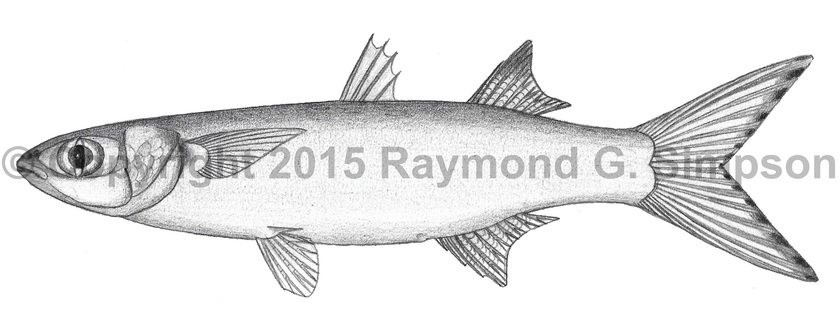
Common Name
Dwarf Mullet
Year Described
Valenciennes, 1836
Identification
Dorsal Fin: IV, 9
Anal Fin: III, 8
Pectoral Fin: II, 13-15
Lateral Scale Rows: 34-37
Transverse Scales: 12-13
Circumpeduncular Scales: 17-18
Gill Rakers: 22-56 (lower limb of first arch)
Body elongate; cylindrical anteriorly and becoming more compressed posteriorly. Snout narrowly blunt. Top of head flat. Eye diameter greater than snout length. Subterminal mouth reaches anterior margin of orbit. Teeth with noticeably curved tips. Adipose eyelid present (absent in juveniles). Spiny dorsal fin situated at mid-point of body. Anal fin inserted slightly forward of or even with second dorsal fin. Dorsal and anal fins densely covered with small scales. Pectoral fin high on side and not reaching dorsal fin origin. Tail forked. Body scales with minute spines.
Color
Body whitish grading to darker dorsally. Center of scales on mid-body with dark centers forming faint stripes on body. Dorsal, pectoral, and caudal fins with dense melanophores. Second dorsal fin with a dark tip. Ventral fins generally pale with a sprinkling of melanophores. Tail margin dark. A large blotch on the pectoral base and axil. Eye color pale with a yellow upper margin.
Size
Maximum size to about 20cm SL
Habitat
Found inshore and in estuarine waters.
Range
Verified from the Brazilian coast from the Amazonian outflow to the SE coast. Occurrence in the Caribbean Sea (Bahamas to the Antilles), Bermuda, and South America north of Brazil need to be confirmed.
References
Durand, J.D., K.N. Shen, W.J. Chen, B.W. Jamandre, H. Blel, K. Diop, M. Nirchio, J.J. Garcia de Léon, A.K. Whitfield, C.W. Chang & P. Borsa. 2012. Systematics of the grey mullets (Teleostei: Mugiliformes: Mugilidae): Molecular phylogenentic evidence challenges two centuries of morphology-based taxonomy. Molecular Phylogenetics and Evolution, 64, 73–92.
Harrison, I.J. 2002. Mugilidae (pp 1071-1085). In: Carpenter. 2002. The living marine resources of the Western Central Atlantic. Vol. 2: Bony fishes part 1 (Acipenseridae-Grammatidae). FAO Species Identification Guides for Fisheries Purposes. American Society of Ichthyologists and Herpetologists Special Publication No. 5.
Menezes, N.A., M. Nirchio, C. Oliveira & R. Siccharamirez. 2015. Taxonomic review of the species of Mugil (Teleostei: Perciformes: Mugilidae) from the Atlantic South Caribbean and South America, with integration of morphological, cytogenetic and molecular data. Zootaxa 3918 (1): 1-38.
Siccha-Ramirez, Z.R., N.A. Menezes, M. Nirchio, F. Foresti & C. Oliveira 2014. Molecular identification of mullet species of the Atlantic South Caribbean and South America and the phylogeographic analysis of Mugil liza. Reviews in Fisheries Science & Aquaculture, 22 (11), 86–96.
Other Notes
This species has been recorded in Harrison (2002) as being found throughout the Caribbean Sea to northern South America, but Menezes et al. (2015) found no verified specimens north of Brazil. A alleged specimen from the Caribbean is actually Mugil trichodon, which is very similar to M. curvidens but has 9 anal fin rays instead of the 8 anal fin rays in the latter species. All specimens from the Caribbean should be checked to determine is M. curvidens has a wider distribution.
Similar to Mugil trichodon, which is easily distinguished by having 8 second dorsal fin elements (vs 9) and higher modal scale counts. The only other mullets with 8 branched rays in adults are M. liza and M. cephalus, which have a mostly unscaled dorsal and anal fin.